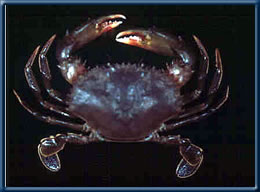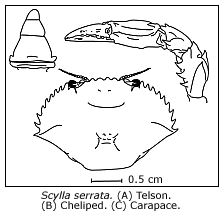

Balanus amphitrite

Balanus eburneus

Chthamalus proteus

Gonodactylaceus falcatus

Ligia exotica

Pachygrapsus fakaravensis

Scylla serrata
Scylla serrata
 Samoan
Crab
Samoan
Crab
Mangrove Crab, Mud Crab
Phylum Arthropoda
Subphylum Crustacea
Class Malacostraca
Order Decapoda
Infraorder Brachyura
Family Portunidae
Description
This is the largest portunid in Hawaii, exceeding 18 cm in width of carapce.
The carapace is smooth, the front bearing four blunt teeth and along the
anterolateral border nine sharp teeth of about equal size. The claws of
the males become very large. It is either entirely grayish green or purplish
brown in color.
 Habitat
Habitat
This crab inhabits muddy bottoms in brackish water along the shoreline,
mangrove areas, and river mouths.
Distribution
Hawaiian Islands
All main islands
Native Range
Indo-Pacific, from South Africa to Tahiti, north to Okinawa, and south
to Port Hacking, Australia and the Bay of Islands, New Zealand.
Present Distribution
Throughout the Indo-Pacific, from Japan, China, Philippines, and Hawaiian
Islands to Australia, Indonesia, East and South Africa, and the Red Sea.
Also introduced to Gulf of Mexico (Florida), status unknown.
Mechanism of Introduction
Intentional, to establish a commercial crab fishery. Crabs from Samoa
released on Oahu, Molokai, and Hawaii.
Impact
Prized, sought-after commercial species. Ecological impact unstudied in
Hawaii, but it is a large, active and aggressive carnivorous species that
undoubtedly feeds on native invertebrate species.
Ecology
Feeding
S. serrata is primarily a carnivore, eating
mollusks, crustaceans, and polychaetes, as well as small amounts of plants
and debris.
Reproduction
Crabs are gonochoristic (having male and female individuals in the same
population). Mating of S. serrata take place
as early as the first year of life after the female undergoes a precopulatory
molt. Recent studies in northern Australia, have shown that the transition
of immature crabs to physiological maturity probably occurs between 90-110
mm carapace width (Knuckey, 1996). During copulation, a male approaching
a female in premolting condition climbs over her, clasps her with his
chelipeds and the anterior pair of walking legs, and carries her around.
They may remain so paired for 3 to 4 days until the female molts. The
male then turns the female over for copulation, which usually lasts 7
to 12 hours. Although the spermatozoa of S. serrata
are non-motile, sperm can be retained by the female, and fertilization
may not take place for many weeks or even months after spawnings (Chen,
1976). While most of the life cycle of S. serrata
is spent in inshore waters, especially estuaries, the females migrate
offshore with the fertilized eggs attached to the pleopods, where they
hatch in a few weeks (Hill, 1996).
Remarks
The Samoan crab was first introduced into Kaneohe Bay, in order to start
a fishery in 1926. Between 1926 and 1935, 98 crabs were released on Oahu,
Hawaii, and Molokai, all from Samoa (Brock 1960). By 1940 it had "already
become thoroughly established about our shores, entering estuaries of
streams and ascending far up some of the larger rivers" (Edmondson
and Wilson, 1940). Edmondson (1954) noted that large specimens may exceed
20 cm in breadth and weigh several pounds. Maciolek and Timbol (1981)
reported it from the Kahana Estuary, Oahu, based on collections made from
1969 to 1971. Eldredge (1994) noted that as of 1992 it was one of the
major species collected in certain areas of the island of Hawaii.
Brock (1960) attributed part of the success of the crab, in light of the
relatively few individuals released, as being due in part to the fact
that some of the estuarine areas where this species was released have
a low rate of tidal flushing, a situation which may be conducive to the
rapid growth of a population within the estuarine area.
References
Brock, V. 1960. The introduction of aquatic animals into Hawaiian water.
Int. Revue Hydrobiol. 45: 463-480.
Chen, T. P. 1976. Aquaculture Practices in Taiwan. Fishing News Books
Limited, Surrey, England. 162 pp.
Edmondson, C.H. and I.H. Wilson. 1940. The shellfish resources of Hawaii.
Sixth Pac. Sci. Congress, Univ. Calif. Press, Berkeley. pp. 241-243.
Edmondson, C.H. 1954. Hawaiian Portunidae. B.P. Bishop Mus. Occ. Pap.
21(12): 217-274.
Eldredge, L.G. 1994. Introductions of commercially significant aquatic
organisms to the Pacific Islands. South Pacific Commission (Noumea, New
Caledonia), Inshore Fisheries Research Project, Tech. Rept. 7.
Hill, B. J. 1996. Offshore spawning by the portunid crab Scylla
serrata (Crustacea: Decapoda). Marine Biology 120: 379-384.
Knuckey, I. A. 1996. Maturity in male mud crabs, Scylla
serrata, and the use of mating scars as a functional indicator.
Journal of Crustacean Biology 16(3): 487-495.
Maciolek, J.A. and A.S. Timbol. 1981. Environmental features and macrofauna
of Kahana Estuary, Oahu, Hawaii. Bull. Mar. Sci. 31: 712-722.
© 2002 Hawaii Biological Survey, Bishop Museum
contact